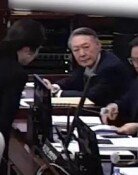Absolute Authority: Its Fatal Attraction
Absolute Authority: Its Fatal Attraction
Posted December. 16, 2003 23:19,

Would there be any other ring in this world that carries something much more than such vain promises as this one does?
It seems like the Lord of the Rings marks a successful period with its completed sequel of The Lord of the Rings The Return of the King that opens in the theaters of 70 countries around the world on December 17. This movie has been greatly expanded in its scope of the storyline and visual effects compared to the last two movies so that it is simply unbelievable that this was the complete sequel of the Rings triology that were all consecutively produced at once. The movie drives its suspense and tension to their height while showing the fellowship of Frodo, Gandalf, and Aragon happening in three different places with parallel editing as well as focusing more on the inner psychology of Frodo and the different characters around him. Frodo and Sam with their duty to destroy the One Ring, and Merry and Pippin, who were busy making an endless array of mistakes in the last movies, now stand out as the heroes of their fight against their own destiny in this movie.
Sauron attacks Gondor to destroy the human species with his army of 200,000, and Gandalf (Ian McKellen) and Theoden (Bernard Hill) are gathering all the armies of Gondor and Rohan in a desperate defense. Aragon (Viggo Mortens), Legolas (Orlando Bloom), and Gimli (John Rhys-Davies) receive aid from ghost warriors and face a great battle against the united army of Sauron in the Pelennor Fields. Meanwhile, Frodo (Eljah Wood) is misled by the deceitful Gollum and distances himself from his loyal friend Sam (Sean Astin) progressively. Frodo starts to hesitate in the face of the Rings attraction at the very moment of throwing it away, and that is when Gollum falls down on him.
Oddly enough, the last sequel focuses on Gollum than on any other character. Multiple personality character Gollum seems as if he is competing with Sam to earn Frodos favor, but in fact, he is like a mirror reflecting the split mind of Frodo. Gollum does not give up on his desire until the last minute and throws himself for it, and Frodo becomes a slave for his desire deserting his duty. The irony that the ring is destroyed in the midst of the conflict between these two characters is technically blurring the dichotomy of the good against the evil structure and throwing a question onto us about the nature of human desire. Gollum, who stinks with lies and deception, stops Frodo from being a second Gollum himself.
The scope of the special effects has been magnified, but it is more physical and bodily. 200,000 digital characters appear in the scenes of the battle in the Plennor Fields, which is 20 times more than 100,000 digital characters in the Hellum Valley battle in the second movie. The angles of the camera accentuate each character while viewing over the characters from the sky and suddenly dropping close to them. The camera walk that follows the heavy cannon ball drastically manifests middle age epic dramas. The extreme close-ups are effective in coloring the movie with its psycho-dramatic tone while showing the eyes of the characters, including Gollum and Frodo, close up. There are very creative characters such as the monster Oliphaunt, resembling an elephant, runs around the battlefield and the super spider Shelob with its smell of a uterus of a diabolique.
Director Peter Jackson has lowered the level of this movie so that modern-day people can feel this mythical world just like their everyday life story of envy, faith and love with miniature, computer graphics, and real footage. The skillfulness of the director is comparable to the power of the original book. Audience of Age over 1. Movie length of three hours and thirty minutes.
Seung-Jae Lee sjda@donga.com



![[단독]김경 “1억원 줄때, 강선우도 함께 있었다” 자수서](https://dimg.donga.com/c/138/175/90/1/wps/NEWS/IMAGE/2026/01/14/133148772.5.jpg)


![반찬통 착색 고민 끝…‘두부용기’ 버리지 말고 이렇게 쓰세요 [알쓸톡]](https://dimg.donga.com/c/138/175/90/1/wps/NEWS/IMAGE/2026/01/09/133126593.3.png)
